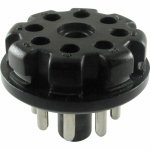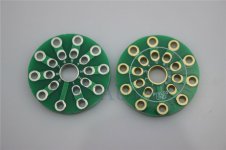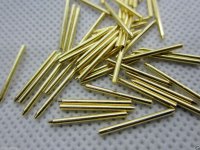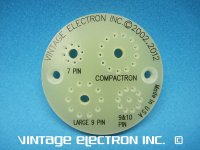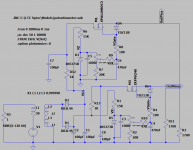Really enjoying this thread!
1) I would appreciate some additional recommendations as to bench power supplies.
2) Any ideas as to UX-4 sockets and 9-pin sockets for experimentation like those octal ones?
1) I would appreciate some additional recommendations as to bench power supplies.
2) Any ideas as to UX-4 sockets and 9-pin sockets for experimentation like those octal ones?
UX4 is a bit hard, there are chinese knockoffs of the CMC tube sockets that can be used. to design a proto board, But TBH just drill a piece of aluminium with the socket on it, and add some jacks or whatever floats your boat.
I have made some experimenting boards for tubes, that can be ordered from china from the comfort of your lounge chair.
V4lve lover's free gerbers thread.
I have made some experimenting boards for tubes, that can be ordered from china from the comfort of your lounge chair.
V4lve lover's free gerbers thread.
For UX-4 one could make an adapter socket to an Octal plug. Various types.
Can also make tube adapters using 9 pin PCB spacers and pins (Ebay). A Pin Straightener is useful for holding the pins aligned.
https://www.diyaudio.com/forums/tub...rophoresis-hv-power-supplies.html#post5065436
https://www.diyaudio.com/forums/tub...lt-commercial-power-supplies.html#post2630507
https://www.diyaudio.com/forums/tubes-valves/250257-bench-power-supply.html#post3798207
Can also make tube adapters using 9 pin PCB spacers and pins (Ebay). A Pin Straightener is useful for holding the pins aligned.
https://www.diyaudio.com/forums/tub...rophoresis-hv-power-supplies.html#post5065436
https://www.diyaudio.com/forums/tub...lt-commercial-power-supplies.html#post2630507
https://www.diyaudio.com/forums/tubes-valves/250257-bench-power-supply.html#post3798207
Attachments
Last edited:
We are DIY so you could build your supplies.
I built this one for the bias function.
It supports is +/- 100Vdc.
The schematics for the Heath kit are available as well so it is possible to build an HV supply like it.
I built this one for the bias function.
It supports is +/- 100Vdc.
The schematics for the Heath kit are available as well so it is possible to build an HV supply like it.
Attachments
There are some YouTube videos about bending and cutting old LP records (those $0.50 ones from the antique shops). No more than 200 degrees in the oven to soften them up, without turning them into toxic gases. Can bend or cut them while hot.
Form a cut up record into a fan, maybe can drop it over a metal fan blade of similar size to form it symmetrically and re-heat to form fit. Make sure the cut lines are accurately spaced for good balance.
Use the completed "fan" blade with a permanent magnet motor as a windmill.
Good breeze at the peak of the house roof on a small tripod. Charge a battery for peak power demand. Use a row of them along the roof peak for more power.
If it's just for novelty, then mount two or four tripod/fans on an LP player turntable and let the windmills spin around for steady power. Will need slip rings for the electrical channel though. Well, could just use another powered fan to blow them, but that would look toooo.. much like cheating.
Can also get pre-made two blade RC model airplane propellers of pretty good size.
Form a cut up record into a fan, maybe can drop it over a metal fan blade of similar size to form it symmetrically and re-heat to form fit. Make sure the cut lines are accurately spaced for good balance.
Use the completed "fan" blade with a permanent magnet motor as a windmill.
Good breeze at the peak of the house roof on a small tripod. Charge a battery for peak power demand. Use a row of them along the roof peak for more power.
If it's just for novelty, then mount two or four tripod/fans on an LP player turntable and let the windmills spin around for steady power. Will need slip rings for the electrical channel though. Well, could just use another powered fan to blow them, but that would look toooo.. much like cheating.
Can also get pre-made two blade RC model airplane propellers of pretty good size.
Last edited:
I encourage the use of LTSpice and PSUDII modeling whenever possible. It saves a LOT of trial and error breadboarding. Once I had modeled all the circuits of my 833 amps multiple times I went straight into my build, and it was successful the first time, with a few minor adjustments. The great thing about modeling is you can do really stupid things and not annihilate expensive components or start fires.
^^^
This.
I spend on the layout is to detrmine where the transformers go without incurring hum (or other nastiness).
If yuo have already a working tube amplifier then you can take a new output transformer and "hover" it around a working mains transformer to figure out the best orientation without inducing hum. Just hook up a mV meter to the primary winding of the OPT. (not all OPT pick up magnetic fields in the same way, been caught before)
- Home
- Amplifiers
- Tubes / Valves
- How do you develop/breadboard valve amplifier circuits?

